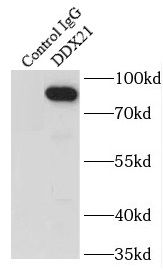Products
DDX21 antibody
| Size | Price |
|---|---|
| 100µg | Inquiry |
- SPECIFICATIONS
- FIGURES
- CONDITIONS
- FAQS
- Product Name
- DDX21 antibody
- Catalogue No.
- FNab02299
- Size
- 100μg
- Form
- liquid
- Purification
- Immunogen affinity purified
- Purity
- ≥95% as determined by SDS-PAGE
- Clonality
- polyclonal
- Isotype
- IgG
- Storage
- PBS with 0.02% sodium azide and 50% glycerol pH 7.3, -20℃ for 12 months(Avoid repeated freeze / thaw cycles.)
- Immunogen
- DEAD(Asp-Glu-Ala-Asp) box polypeptide 21
- Alternative Names
- Nucleolar RNA helicase 2|DEAD box protein 21|Gu-alpha|Nucleolar RNA helicase Gu|Nucleolar RNA helicase II|RH II/Gu|DDX21 antibody
- UniProt ID
- Q9NR30
- Observed MW
- 87 kDa
- Tested Applications
- ELISA, WB, IHC, IF, IP
- Recommended dilution
- WB: 1:500-1:2000; IP: 1:200-1:1000; IHC: 1:20-1:200; IF: 1:20-1:200
 HepG2 cells were subjected to SDS PAGE followed by western blot with FNab02299(DDX21 antibody) at dilution of 1:2000
HepG2 cells were subjected to SDS PAGE followed by western blot with FNab02299(DDX21 antibody) at dilution of 1:2000
 IP Result of anti-DDX21 (IP:FNab02299, 4ug; Detection:FNab02299 1:1000) with COLO 320 cells lysate 2800ug.
IP Result of anti-DDX21 (IP:FNab02299, 4ug; Detection:FNab02299 1:1000) with COLO 320 cells lysate 2800ug.
 Immunohistochemistry of paraffin-embedded human colon cancer using FNab02299(DDX21 antibody) at dilution of 1:100
Immunohistochemistry of paraffin-embedded human colon cancer using FNab02299(DDX21 antibody) at dilution of 1:100
- Background
- RNA helicase that acts as a sensor of the transcriptional status of both RNA polymerase(Pol) I and II: promotes ribosomal RNA(rRNA) processing and transcription from polymerase II(Pol II)(PubMed:25470060). Binds various RNAs, such as rRNAs, snoRNAs, 7SK and, at lower extent, mRNAs(PubMed:25470060). In the nucleolus, localizes to rDNA locus, where it directly binds rRNAs and snoRNAs, and promotes rRNA transcription, processing and modification. Required for rRNA 2'-O-methylation, possibly by promoting the recruitment of late-acting snoRNAs SNORD56 and SNORD58 with pre-ribosomal complexes(PubMed:25470060, PubMed:25477391). In the nucleoplasm, binds 7SK RNA and is recruited to the promoters of Pol II-transcribed genes: acts by facilitating the release of P-TEFb from inhibitory 7SK snRNP in a manner that is dependent on its helicase activity, thereby promoting transcription of its target genes(PubMed:25470060). Functions as cofactor for JUN-activated transcription: required for phosphorylation of JUN at 'Ser-77'(PubMed:11823437, PubMed:25260534). Can unwind double-stranded RNA(helicase) and can fold or introduce a secondary structure to a single-stranded RNA(foldase)(PubMed:9461305). Involved in rRNA processing(PubMed:14559904, PubMed:18180292).
How many times can antibodies be recycled?
First, usually it's not suggested to recycle antibodies. After use, buffer system of antibodies has changed. The storage condition of recycled antibodies for different customers also varies. Thus, the performance efficiency of recycled antibodies can’t be guaranteed. Besides, FineTest ever conducted the antibody recycling assay. Assay results show recycling times of different antibodies also varies. Usually, higher antibody titer allows more repeated use. Customers can determine based on experimental requirements.
Notes: After incubation, we recycle rest antibodies to centrifuge tube and store at 4℃. High titer antibodies can be stored for a minimum of one week. Reuse about three times.
What are components of FineTest antibody buffer?
Components of FineTest antibody buffer are usually PBS with proclin300 or sodium azide, BSA, 50% glycerol. Common preservative is proclin300 or sodium azide, which is widely applied in the lab and industry.
How about the storage temperature and duration of FineTest antibodies?
Most antibodies are stored at -20℃. Directly-labeled flow cytometry antibodies should be stored at 2 - 8℃. The shelf life is one year. If after sales issues for purchased antibodies appear, return or replacement is available. Usually, antibodies can be still used after the one-year warranty. We can offer technical support services.
Is dilution required for FineTest antibodies? What’s the dilute solution?
Directly-labeled flow cytometry antibodies are ready-to-use without dilution. Other antibodies are usually concentrated. Follow the dilution ratio suggested in the manual. Dilute solution for different experiments also varies. Common antibody dilution buffers are acceptable(e.g. PBST, TBST, antibody blocking buffer).
How to retrieve antibodies for immunohistochemistry?
Common retrieval buffers: Tris-EDTA Buffer(pH 9.0); Citrate Buffer(pH 6.0)
Heat induced antibody retrieval:
Method 1: Water-bath heating: Put the beaker with retrieval buffer and slide in the boiling water bath. Keep the boiling state for 15min. Naturally cool to room temperature;
Method 2: Microwave retrieval: Put the beaker with retrieval buffer and slide in the microwave oven. Heat at high power for 5min, Switch OFF for 3min, Heat at medium power for 5min. Naturally cool to room temperature.
How to choose secondary antibodies?
(1) Secondary antibodies react with primary antibodies. Thus, secondary antibodies should be against host species of primary antibodies. E.g. If the primary antibody is derived from rabbit, the relevant secondary antibody should be against rabbit. E.g. goat anti rabbit or donkey anti rabbit.
(2) Choose secondary antibody conjugates according to the experimental type, e.g. ELISA, WB, IHC etc. Common enzyme conjugated secondary antibodies are labelled by HRP, AP etc. Fluorescin or dye labelled secondary antibodies are applied in immunofluorescence and flow cytometry(e.g. FITC, Cy3).
